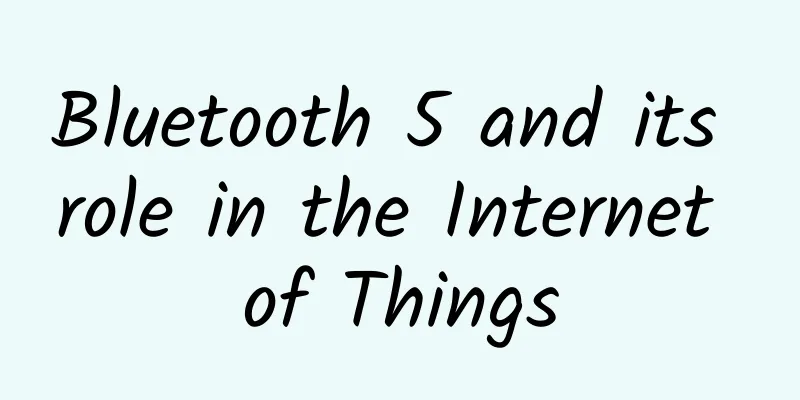Bluetooth 5 and its role in the Internet of Things

|
What is Bluetooth 5? If you own a car or a smartphone, you’ve most likely used Bluetooth at least once in your life. Bluetooth is everywhere: speakers, wireless headphones, cars, wearables, medical devices, even shoes! There are two kinds of Bluetooth devices: one is called Classic Bluetooth (used in wireless speakers, car infotainment systems, and headphones), and the other is called Bluetooth Low Energy (BLE). BLE is more prominent in applications where power consumption is critical (such as battery-powered devices) and where small amounts of data are transmitted infrequently (such as sensor applications). These two types of Bluetooth devices are incompatible with each other (even if they are of the same brand or even have the same specification documents). Classic Bluetooth devices cannot communicate directly with low-power Bluetooth devices. However, there is a dual-mode Bluetooth device on the market, which supports both low-power Bluetooth and classic Bluetooth. Since many IoT systems involve small devices and sensors, Bluetooth Low Energy (BLE) has become the more common protocol of the two (relative to Classic Bluetooth) in the IoT. In December 2016, the Bluetooth Special Interest Group (SIG), the governing body behind the Bluetooth standard, released Bluetooth version 5.0. Most of the enhancements and features introduced in this version focus on Bluetooth Low Energy.
What are the new features of Bluetooth 5.0? So, what’s new in Bluetooth 5.0 compared to previous versions? Three main functions:
Let’s take a closer look at each of these and see what potential IoT applications could leverage them. 1. Twice the speed In earlier versions of Bluetooth (4.2 and earlier), the data rate of Bluetooth Low Energy (BLE) was set to a fixed 1Mbps. In Bluetooth 5.0, a new mode with a data rate of 2Mbps was introduced. This new data rate also provides some additional benefits:
One disadvantage of using 2Mbps mode is that it has the potential to reduce transmission range because the higher speed causes the receiver radio to be less sensitive. However, for applications where sacrificing a little range for higher data speeds is acceptable, there are some scenarios where this is acceptable. Compared to other low-power wireless protocols (e.g. ZigBee, Z-Wave, Thread), BLE offers higher data rates, even at the original 1 Mbps data rate. With the addition of the new high-speed mode (2 Mbps), more potential IoT applications become more feasible. Examples include video streaming, audio streaming, and bursty large data transfers, such as images. 2. Four times the range Bluetooth 5.0 also introduces a long-range mode that utilizes an error correction technique called forward error correction (FEC). FEC allows the receiver to recover data from errors caused by noise and interference. Therefore, when an error occurs, the receiver can use the redundancy in the data to recover the data originally sent, rather than requiring the data to be resent. This long range mode is called Coded PHY mode. The obvious benefit of using this new mode is the increased transmission range, the disadvantage is the increased average power consumption and lower transmission rate (125 kbps or 500 kbps, depending on the coding scheme used). When tested in long range mode, line-of-sight ranges of up to 800 meters have been recorded. This makes it possible to use BLE in applications where communication with devices hundreds of meters away is required. Examples include remote control devices, home automation, and industrial applications. Bluetooth 5.0 will increase the communication distance to four times the original. This means that BLE technology can finally be used in smart homes. Users can use BLE to control smart products at home, from smart bulbs to smart locks. Now all smart devices in a home can be connected using BLE. Compared with WiFi technology, which consumes a lot of power, the advantages of BLE in smart home products are very obvious. 3. Eight times the advertising message capacity In Bluetooth Low Energy (BLE), there are three main states a device can be in, it is advertising, scanning or connecting. To connect two Bluetooth Low Energy devices, one device must advertise and the other must scan and then initiate a connection. Advertising essentially involves advertising packets, which allow another scanning device to discover them, after which the scanning device can decide to initiate a connection. In earlier versions of Bluetooth, the advertising data payload size was capped at 31 bytes. In Bluetooth 5.0, a new advertising mode was introduced: Extended Advertising. Extended Advertising allows up to 255 bytes of payload data to be sent per packet, instead of the original 31-byte limit. Advertising is available in all low-power devices, but one prominent application that takes advantage of this state is beacon technology. A beacon device maintains an advertising state and simply advertises data for others to browse and read. With the increase in advertising data capacity in Bluetooth 5, beacons can now transmit even more data, unlocking more new IoT applications and uses. in conclusion As we can see, Bluetooth 5.0 introduces some features that have a wide range of potential IoT applications. However, there are a few key points to note:
However, despite this, the potential new IoT applications introduced by Bluetooth 5, both on the mobile and embedded side, are bound to see widespread adoption! |
<<: To improve the security performance of SD-WAN, you need to do this
>>: There are three major challenges in data center management
Recommend
QuChain Technology settles in Huawei Cloud and will jointly build integrated blockchain services
On September 6, during HUAWEI CONNECT 2017, Huawe...
LOCVPS newly launched Korean KVM, 20% off for all items, 2G memory package starts at 44 yuan per month
LOCVPS (Global Cloud) has released the informatio...
How to “prevent” programmers from slacking off at work?
[[344451]] This article is reprinted from the WeC...
China Mobile: All new mobile terminals must support 700MHz from October 1
At the launch ceremony of China Mobile's 2021...
How 5G will impact data centers and how to prepare
New 5G networks are increasing connectivity betwe...
Redis actually has a custom network communication protocol?
[[385171]] All network communications require bot...
5G commercialization promotes the scale development of industrial Internet
The Industrial Internet is a network that connect...
The three major operators are making efforts, 5G messaging has begun to be commercialized, and WeChat and QQ are facing great challenges
WeChat and QQ have become the strongest kings in ...
Review of 5G in 2019: 5G sounded the rally call for commercial use
"5G is like a newborn baby, new from head to...
What serious consequences will arise from the “winner takes all” approach among Internet giants?
1. “Winner-takes-all” and multi-sided platforms w...
The 5G commercial license has just been officially issued! Here are ten issues that you should pay attention to
On the morning of June 6, the Ministry of Industr...
On the day of the Chinese college entrance examination, most of the Internet in the world was paralyzed by this "small company"
On June 8, while the college entrance examination...
K8s-Service Mesh Practice-Introduction to Istio
background Finally, we are entering the service m...
my country has initially built the world's largest 5G mobile network
"Since the implementation of network speed-u...
"Interview Eight-part Essay" Network Volume 19
[[422375]] 1.How many layers does the TCP/IP netw...









